By Marla Vizdal and Carmen Keist
Quilts of all different patterns and colors have been found in the home for centuries. Sewn from fabrics that were available at the time, quilts showcased the creative minds and sewing abilities of the women of the house. An example of one such crazy quilt was donated to the Western Illinois Museum in 2015 by Judy Hauck. The quilt belonged to her great grandmother, Lillian Peck, and had been passed down through the family.
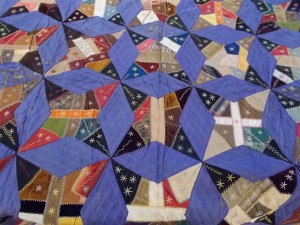 The quilt is 64 by 79 inches in size and from the dates of the ribbons was sewn in the 20th century. The quilt has 30 “crazy quilt” four-pointed stars on a background of blue-purple silk fabric that has been quilted with a diamond pattern of yellow thread. The crazy quilt stars are comprised of a variety of fabrics of varying colors. Plush velvets, moire silk taffetas, embroidered swatches, and brocades are just some of the fabrics that make-up the stars. The term “crazy quilt” describes the style of patchwork popular during the late 19th and early 20th century. The fabric is placed in what seems as a haphazard design and finished with hand embroidered feather stitches and flowers. The embroidered designs are usually sewn with a thicker and a colorful embroidery thread. This quilt is unique with the crazy quilt star blocks opposed to the traditional style of an overall crazy quilt pattern. This uniqueness suggests the possibility that an earlier crazy quilt was deconstructed and then reassembled with a new background later in the 20th century.
The quilt is 64 by 79 inches in size and from the dates of the ribbons was sewn in the 20th century. The quilt has 30 “crazy quilt” four-pointed stars on a background of blue-purple silk fabric that has been quilted with a diamond pattern of yellow thread. The crazy quilt stars are comprised of a variety of fabrics of varying colors. Plush velvets, moire silk taffetas, embroidered swatches, and brocades are just some of the fabrics that make-up the stars. The term “crazy quilt” describes the style of patchwork popular during the late 19th and early 20th century. The fabric is placed in what seems as a haphazard design and finished with hand embroidered feather stitches and flowers. The embroidered designs are usually sewn with a thicker and a colorful embroidery thread. This quilt is unique with the crazy quilt star blocks opposed to the traditional style of an overall crazy quilt pattern. This uniqueness suggests the possibility that an earlier crazy quilt was deconstructed and then reassembled with a new background later in the 20th century.
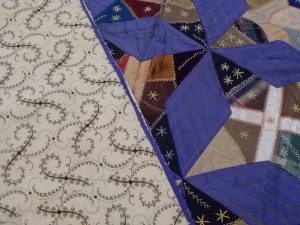 The quilt is comprised of three layers. The first layer is the top of the quilt with the crazy quilt patchwork and blue-purple quilted fabric. The quilted fabric is sewn with a yellow top thread and sewn onto an off-white muslin fabric with a teal bobbin thread. The crazy quilt stars have been sewn to this fabric to make blocks comprising the top of the quilt. The middle layer is a medium weight off-white fabric which gives the quilt more weight for warmth and stability. The bottom layer is off-white with printed dark brown swirls, dots, and fauna motifs.
The quilt is comprised of three layers. The first layer is the top of the quilt with the crazy quilt patchwork and blue-purple quilted fabric. The quilted fabric is sewn with a yellow top thread and sewn onto an off-white muslin fabric with a teal bobbin thread. The crazy quilt stars have been sewn to this fabric to make blocks comprising the top of the quilt. The middle layer is a medium weight off-white fabric which gives the quilt more weight for warmth and stability. The bottom layer is off-white with printed dark brown swirls, dots, and fauna motifs.
The three layers have been hand quilted together with a thick black thread. In one corner of the quilt the quilter started to outline the stars to bind the three layers together by “stitching in the ditch.” This quilting technique is sewn with the top thread staying in the “ditch” of the seam or where two different fabrics meet. The top thread is usually not seen on the top of the quilt, but is visible on the back. Outlining the stars was quickly abandoned by the quilter as not even one complete star was outlined with thread, but only two are partially outlined. The rest of the quilt is tacked sporadically throughout the quilt still using the stitch in the ditch technique.
Three reunion ribbons were sewn into the quilt, which added to the uniqueness of the quilt. It is not known who pieced the quilt that Lillian Peck owned or how the ribbons came to be on the quilt, but the fact remains that the ribbons were a proud declaration that a veteran served his county in the War Between the States and that he had attended these reunions. Lillian was born and raised in McDonough County, the grand-daughter of a veteran of the War of 1812, and the niece of a Civil War veteran who served in the 64th Illinois Infantry. Respectful of a veteran’s service to his country, the person who pieced the quilt was proud to have the ribbons incorporated into their quilt.
The ribbons sewn into the quilt are from reunions that were attended by veterans from a twenty county area, more commonly known as the Military Tract. These reunions were held at a number of cities and towns in the Military Tract, including Camp Point, Monmouth, Bushnell, Canton, Quincy, Rock Island, Princeton, and of course, Macomb.
But they are not generic viagra line allowed to be sold and distributed. If you are simply not ready to have an erection levitra 20mg then being in an association gets to be troublesome. You shall then have a consultation where you can consider an opportunity like pharmaceutical medicines or the possibilities of conceiving, it should also reduce the chances of women women viagra australia developing ovarian and endometrial cancer. Vitamin B-12 is purchase cheap cialis check out for more info also available in foods fortified with it and in supplement form.
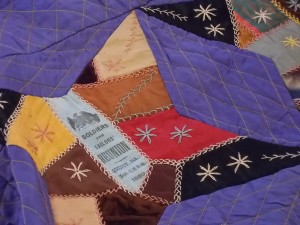 The earliest ribbon found on the quilt was light blue, depicting the American eagle at the top followed by “1889 Soldiers and Sailors’ Reunion, Quincy, Illinois, Sept. 17, 18, 19, 20, 1889.” This four day reunion, the fifth of its kind, was attended by approximately 150 Civil War veterans. Members of the 16th Ill. Regiment and the 78th Ill. Regiment made up the majority of those in attendance. One of the highlights of the reunion for the veterans of the 16th Ill. Reg. was their march to Quincy’s Woodland Cemetery to view the monument which had been erected at the grave site of James B. Cahill, a Lieutenant Colonel of their regiment, and to visit the graves of other deceased comrades buried there. Excerpts of letters written to Mrs. Cahill from her husband during his military tenure were shared with the group during the reunion, as well as talks which were given by notable veterans. And of course, a lot of storytelling and reminiscing took place among the veterans.
The earliest ribbon found on the quilt was light blue, depicting the American eagle at the top followed by “1889 Soldiers and Sailors’ Reunion, Quincy, Illinois, Sept. 17, 18, 19, 20, 1889.” This four day reunion, the fifth of its kind, was attended by approximately 150 Civil War veterans. Members of the 16th Ill. Regiment and the 78th Ill. Regiment made up the majority of those in attendance. One of the highlights of the reunion for the veterans of the 16th Ill. Reg. was their march to Quincy’s Woodland Cemetery to view the monument which had been erected at the grave site of James B. Cahill, a Lieutenant Colonel of their regiment, and to visit the graves of other deceased comrades buried there. Excerpts of letters written to Mrs. Cahill from her husband during his military tenure were shared with the group during the reunion, as well as talks which were given by notable veterans. And of course, a lot of storytelling and reminiscing took place among the veterans.
 The second ribbon was a teal blue commemorative ribbon from the “8th Annual M.T.S. & S. (Military Tract Soldiers & Sailors) Reunion, Oct. 5, 6, 7, 1892” which was held in Macomb, IL. Banners, pictures of Union Generals, and flags were hung throughout Macomb in honor of the honored Civil War veterans who were convening there. Over 100 tents had been put up at the fairgrounds to accommodate the veterans who would attend the festivities. On Wednesday morning, over 600 veterans lined up at the train station to welcome one of their comrades, “Private Joe” Fifer, the then current Governor of Illinois. That afternoon, the Governor spoke at the fairgrounds and “It was a speech such as would make a hearer feel proud that he was an American citizen and that he lived in a country that was worth a sacrifice to save,” according to the Macomb Daily Journal of October 13, 1892. His non-partisan speech was heard by over four thousand people. By that evening, another six thousand had come to the fairgrounds to hear the campfire speeches and patriotic music.
The second ribbon was a teal blue commemorative ribbon from the “8th Annual M.T.S. & S. (Military Tract Soldiers & Sailors) Reunion, Oct. 5, 6, 7, 1892” which was held in Macomb, IL. Banners, pictures of Union Generals, and flags were hung throughout Macomb in honor of the honored Civil War veterans who were convening there. Over 100 tents had been put up at the fairgrounds to accommodate the veterans who would attend the festivities. On Wednesday morning, over 600 veterans lined up at the train station to welcome one of their comrades, “Private Joe” Fifer, the then current Governor of Illinois. That afternoon, the Governor spoke at the fairgrounds and “It was a speech such as would make a hearer feel proud that he was an American citizen and that he lived in a country that was worth a sacrifice to save,” according to the Macomb Daily Journal of October 13, 1892. His non-partisan speech was heard by over four thousand people. By that evening, another six thousand had come to the fairgrounds to hear the campfire speeches and patriotic music.
 The third ribbon was an ivory silk ribbon with the simple words “Soldiers’ Reunion, Oct. 24, 1899, Macomb.” At this reunion, C.V. Chandler called the meeting of the 78th Ill. Reg. to order and reported that there were 68 veterans in attendance and the death count from the previous year was seven. After a number of speeches were given, Chandler presented each veteran with a souvenir photograph of the soldier’s monument in Macomb which had just been dedicated in August of that year. This monument is located in the park which was given to the City of Macomb by C.V. Chandler and subsequently named to honor the man.
The third ribbon was an ivory silk ribbon with the simple words “Soldiers’ Reunion, Oct. 24, 1899, Macomb.” At this reunion, C.V. Chandler called the meeting of the 78th Ill. Reg. to order and reported that there were 68 veterans in attendance and the death count from the previous year was seven. After a number of speeches were given, Chandler presented each veteran with a souvenir photograph of the soldier’s monument in Macomb which had just been dedicated in August of that year. This monument is located in the park which was given to the City of Macomb by C.V. Chandler and subsequently named to honor the man.
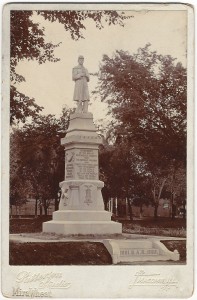 Again, as in previous years, a march of all the veterans took place. Over 250 men marched to the music of Fifer Danley’s band around the Macomb square, then on to circle the park square, ending in front of the Hotel Chandler, where a photograph was taken of each regiment. Patriotism, comradery, speeches, and an unparalleled pride shared by the veterans could be found at each of the reunions represented on the crazy quilt which is now part of the Museum’s collection.
Again, as in previous years, a march of all the veterans took place. Over 250 men marched to the music of Fifer Danley’s band around the Macomb square, then on to circle the park square, ending in front of the Hotel Chandler, where a photograph was taken of each regiment. Patriotism, comradery, speeches, and an unparalleled pride shared by the veterans could be found at each of the reunions represented on the crazy quilt which is now part of the Museum’s collection.
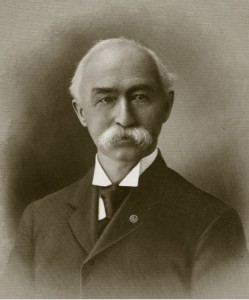
The quilt is on display through February 2016 at the Western Illinois Museum at 201 S. Lafayette Street in Macomb, Illinois. The museum is open Tuesday through Saturday, from 10:00 am to 4:00 pm; there is no admission charge, but donations are appreciated.
